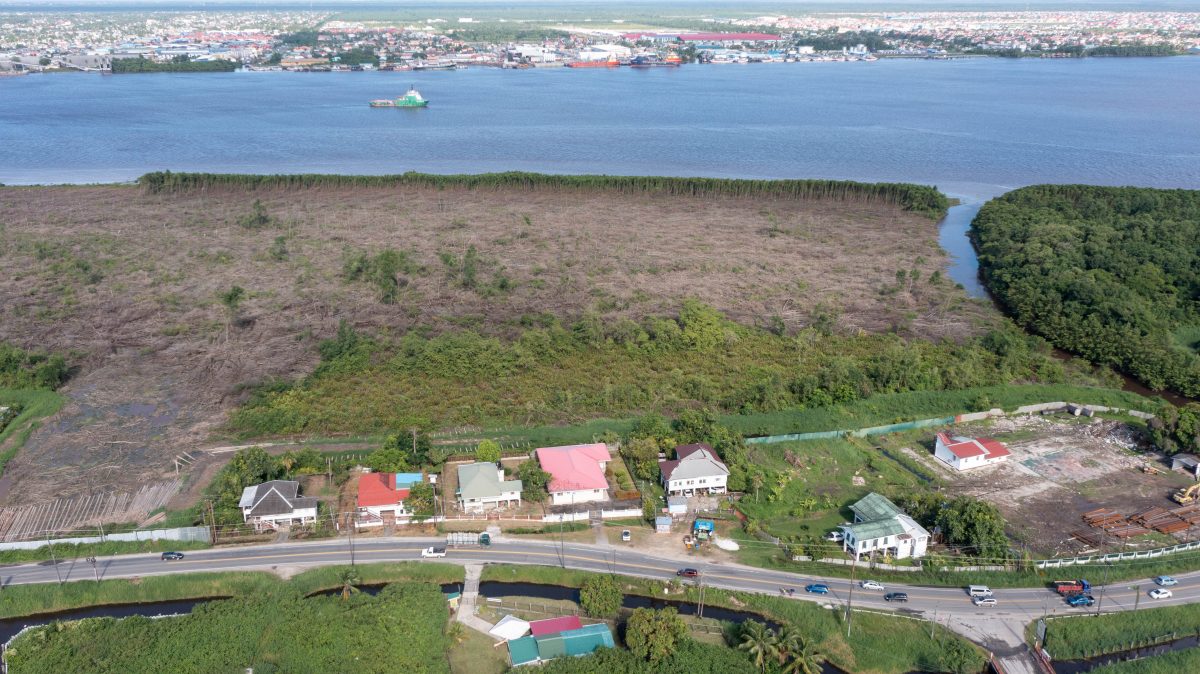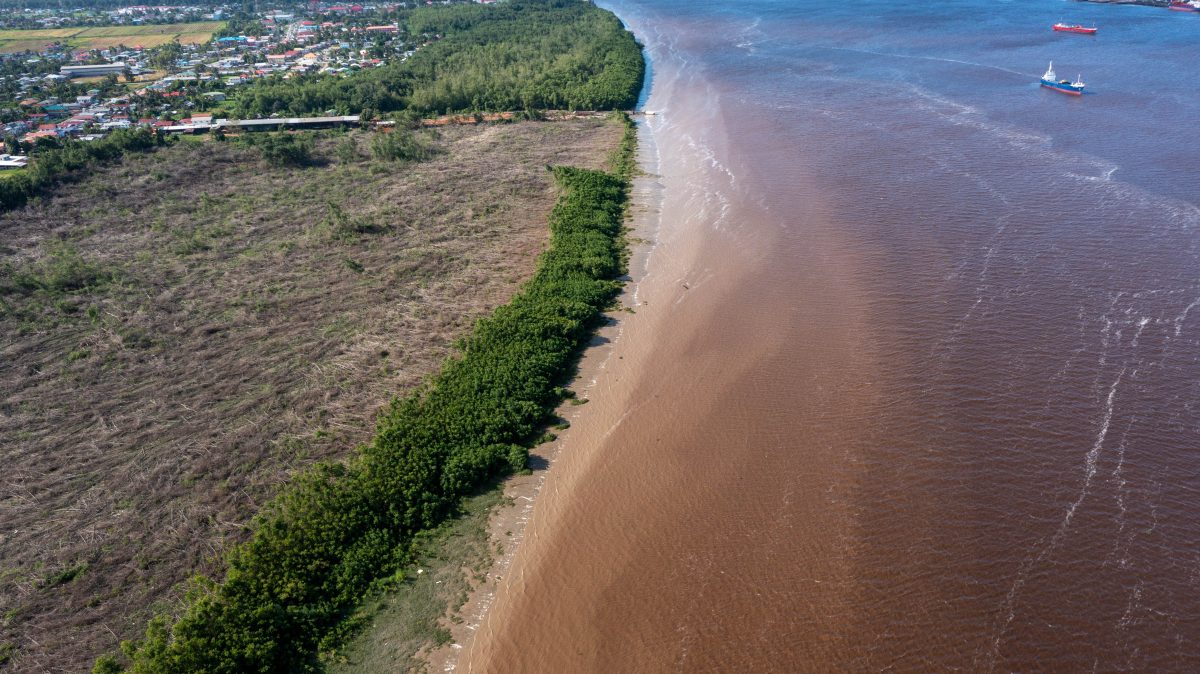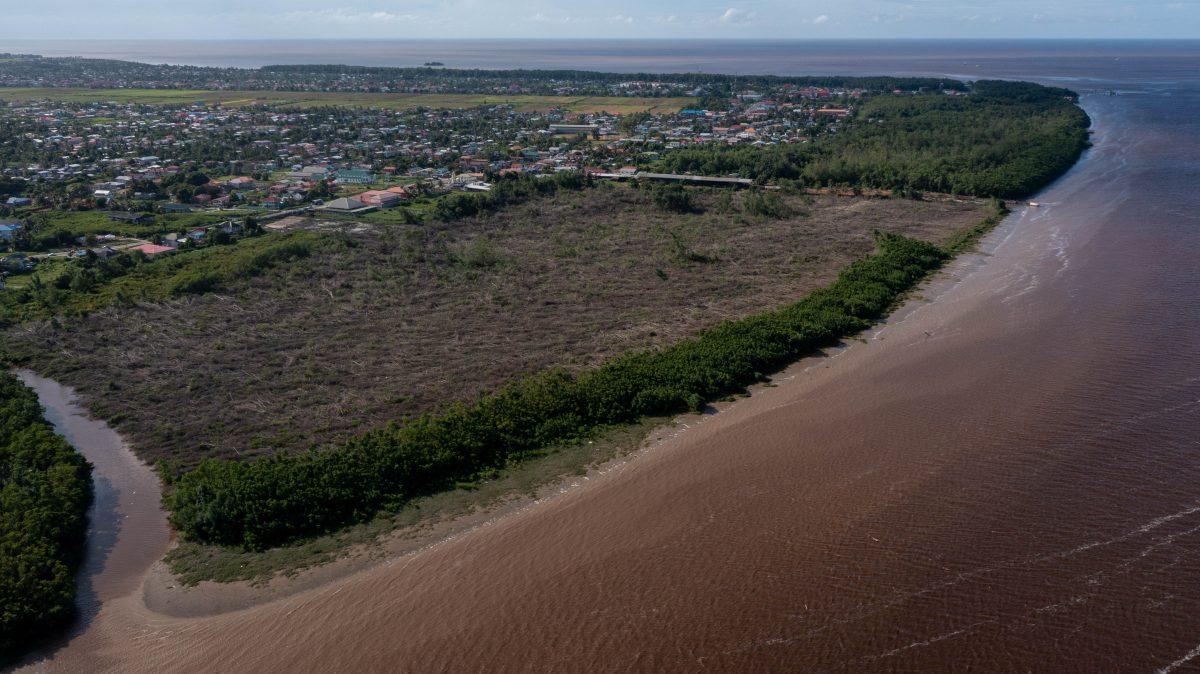The clearing of mangroves by Tristar Incorporated at Malgre Tout/Versailles, West Bank Demerara, has exceeded the terms under which it was granted permission to begin work to construct a shore base facility, according to Chairman of Guyana’s Sea Defence Board Brigadier (ret’d) Gary Beaton.
Beaton, in an interview yesterday, told Stabroek News, that the developer cleared a large amount of mangroves, which it was not permitted to do, and has so far failed to make provisions to rebuild a river defence.
“They are in breach of the guidelines we offered with our no objection. They have destroyed the sea defence without building one area, and they were expected to provide a work plan and schedule but that was not done,” Beaton explained when asked about the breaches committed by the developer.

He said as a result of the situation the Board would be summoning the developer to a meeting.
Works commenced in January for the project.
A visit this week by Stabroek News revealed that a substantial amount of mangroves have been cleared along the shoreline earmarked for the project and residents have express-ed worry that they are now vulnerable to flooding, especially since the May/ June rainy season has started.
Aerial images commissioned by this newspaper have revealed a devastating situation as a vast swathe of the mangrove forest has been cleared and the developers are in the process of clearing the final stretch of the protected plants on the foreshore.

Beaton related that moving forward the designs and plans of the developer would have to be evaluated by engineers to ensure they are “engineering sound” to withstand the challenges of rising sea levels and meet all necessary requirements.
He is hopeful that the board will be able to meet with the company’s principals as early as next week.
Meanwhile, Stabroek News has learnt that the approval for the project was held up last year by the Environmental Protection Agency (EPA) given its concerns over the clearing of mangroves.
Former head of the agency Dr. Vincent Adams told Stabroek News that the application for the project was made while he was head of the agency and was being evaluated by the EPA in collaboration with other agencies.
During assessments, Adams said, the EPA had met with Winston Brassington, who was leading the project at the time, along with other directors and they were told of the approvals needed before the EPA could give a greenlight.
During that meeting, Adams said that he informed the principals that no approval would be given until every agency gave their input and carried out proper evaluations.
Up to when Adams was fired by the government there had been no approval of the project.
So far, key agencies such as the EPA, and the National Agricultural Research and Education Institute (NAREI) have remained silent on the situation.
Enquiries from this newspaper to the EPA, were directed to the agency’s acting head Sharifah Razack. Her Secretary informed that she was in a meeting and advised for enquiries to be sent to her email. Up to press time, there was no acknowledgement or any response to the questions.
Chief Executive Officer of NAREI Jagnarine Singh, when contacted yesterday by Stabroek News for a second time informed that he will not be commenting on the issue.
Mixed messages
Region Three Chairman Ishan Ayube when questioned if his council has any reservations over the project and the impact it will have on the river defence, responded in the negative.
“The Maritime Adminis-tration, the Sea Defence Board and other technical agencies have done their surveys and if they give permission it ought to be safe,” Ayube said, while noting that the council doesn’t see the clearing of the mangroves as a burden to the region.
He pointed out that it is up to the company to abide by agreements in place and act in good faith.
According to Ayube, the project should been viewed as a positive for the region given its economic impact and ability to generate jobs.
However, Deopaul Somwaru, a volunteer with local group “A Fair Deal for Guyana,” in response to the destruction of the mangroves, said it is sending the wrong message.
“It shows that government is not serious about the protection of these plants and the environment. There has been so many public education programmes that have seen groups highlighting the need for the protection of mangroves but here they are being destroyed,” Somwaru, also a biology student, said.
He pointed out that while persons are looking at what can be termed a significant development for the region, not only mangroves but natural habitats and livelihoods are being destroyed.
“Where there is healthy mangroves, there [are] great benefits for fishing. Destroying the habitat not only hurts the environment but impacts the lives of fishermen and their catch,” he added.
When residents recognised that the destruction of the mangroves had possibly exceeded the amount that what was approved, they began to question what sort of river defence will be put in place to protect them.
“We are concerned as mangroves provide coastal defence against flooding… and their removal is a major concern to us…flooding remains a major concern to us,” resident Shawn Johnson said in a letter to Stabroek News on behalf of other residents.
Additionally, when Stabroek News spoke with the Chairman of the Malgre Tout/Met-en-Meerzorg Neighbourhood Democratic Council, Tennessee Vickerie, he explained that during consultations the council had raised objections to the destruction of the mangroves. He noted that it communicated its concern among others to the Central Housing and Planning Authority and other agencies during the process for approval of the project.
Mangroves are a protected species and concerns have been expressed previously that the oil and gas industry will pose a threat to large swathes.

